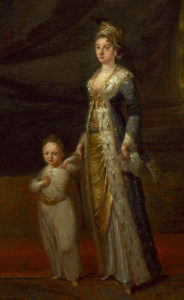Or, How Garment Scholars Confused Everybody, Including Themselves
[In progress]
Jennifer Scarce managed to spend an entire chapter of Women’s Costume of the Near and Middle East discussing Ottoman Turkish women’s dress without once naming the hip-length robe all the women wore.
Hülya Tezcan, former head of the Topkapi Museum’s textile department and prolific author of books and articles about court dress, slid past the question of what the hip-length robe was called by vaguely waving the term iç entari, “inner entari,” at it. (She also identified an extant example as an outer jacket.)
SCAdian garb-makers sometimes call it a hırka, though no one seems to know where the term came from, much less how to pronounce it.
And if you search for “zıbın,” Google shows you this:
One of the enduring problems with Ottoman Turkish scholarship is that the vocabulary comes from the 18th century. Another enduring problem is that no one, including Turkish scholars, seems to have noticed.
And the 16th century is not the 18th century. The 16th century is so very, very not the 18th century. Even distinguished scholars like Jennifer Scarce and Hülya Tezcan draw a blank when they try to put a name to the short underjacket that all 16th-century women (and many men) wore, because by the 18th century, the word they’re looking for had come to mean “thermal undershirt.”
So how did the gorgeous brocade jackets of the 16th century turn into the onesies and long johns of the 21st century? And how do we know that “zıbın” is the word we’re looking for, anyways?
Move Over, I Want a Clean Plate
From the 16th century to the early 18th century, the layers of women’s clothes shifted inward. First the outer layer came to be known by two names, then one of the names shifted onto the inner layer, and the name of the inner layer was jostled onto a new innermost layer.
Let’s start at the beginning. Until the early 17th century, these were the standard layers:
[Image with labels: kaftan and zıbın]
“But wait,” you say, “what about ‘entari’? Wasn’t that what they called the long robe?”
Nope.
Certainly the word “entari” was around. It was the Turkish pronunciation of the Greek word anteri, and it appears from time to time in travelers’ accounts. But in Suraiya Faroqhi’s study of 15th-century women’s estate inventories, my own study of 16th-century Üsküdar estate inventories, and my study of late 16th and early 17th-century Galata inventories, the word appears a grand total of one time: in the 1613-1615 estate inventory of Kerime bt. Süleyman, who left behind an “anteriye” worth 50 akçes.1 Entari/anteri simply wasn’t in common use. The term for the long robe was “kaftan.”
Then there’s a gap in the records from 1620 to 1641, and when we return to Galata, anteris and entaris are all over the place. Fâtıma Hatun bt. İbrahim owns a red anteri and an anteri of kemha brocade, but no kaftans2; Seyyid Ahmed Ağa owns a white anteri, an “entari kaftan,” and three regular kaftans.3 The scholar Hüseyin Efendi b. İslâm owns “an entari and a white zıbın” as well as an old kaftan.4 No small number of people own only entaris, or only kaftans, and plenty of people own both.
What changed? Was the entari a new style of kaftan? Or was it just a sexy new word? We have no idea, and without far more mining of primary sources than my Turkish can handle, we have no way of knowing. The 1640 Istanbul market price list gave detailed descriptions of kaftans, but didn’t mention entari, which suggests that either the entari was too new to regulate–unlikely, given the number of people who died in 1641 owning them–or entari were enough like standard kaftans to be covered by kaftan regulations.
Meanwhile, the zıbın underwent a sea change. The 1624 official market price list gives prices for two sizes of inexpensive “zıbun” made of warm, cheap aba wool and several varieties of cotton zıbıns, some quilted,5 but doesn’t mention a single silk zıbın, much less one of kemha or seraser brocade. The 1624 zıbıns are priced in groups of three to six as well as individually, suggesting that wearers could buy them in packs the same way we buy underwear. When Sultan Murad IV went to war in 1634 he packed 194 zıbıns, but in a wardrobe jammed with luxurious fabrics, 26 of his zıbıns were humble cotton twill, 11 were generic cotton, 126 were the silk-and-cotton blend known as kutni or kutnu, and only 31 were silk satin.6 That’s the imperial Ottoman equivalent of having a really nice collection of silk boxers. By 1624, zıbıns had changed from clothes that were meant to be seen, to clothes you wore under the clothes that were meant to be seen.
But styles hadn’t changed. That’s the mysterious part. Styles hadn’t changed. The beauties depicted in bazaar paintings in 1618-1625 wore the same short jackets their mothers did in 1600 or their grandmothers did in 1575, and the jackets were in the same fine fabrics, and the estate records don’t contain any new terms that might be a new name for the old jackets.
Did women wear showy zıbıns longer than men did? It’s a possibility. Men appeared in public far more than women did, so their zıbıns would be hidden by their formal clothes for most of the day. Sultan Murad IV would have gotten less use out of a fine zıbın than Kösem Sultan. In 1655-1669, estate records from Edirne documented zıbıns made of watered silk and other showy fabrics, so somebody was still splashing out on their underjackets.7
In any case, by 1641, these were the standard layers of a woman’s outfit:
[Image with labels: kaftan/entari and zıbın]
But jump to 1717, and Lady Mary Wortley Montagu describes a completely different set of layers:
The antery is a waistcoat, made close to the shape, of white and gold damask, with very long sleeves falling back, and fringed with deep gold fringe, and should have diamond or pearl buttons. My caftan, of the same stuff with my drawers, is a robe exactly fitted to my shape, and reaching to my feet, with very long strait falling sleeves. Over this is my girdle, of about four fingers broad [….]. The curdee [kürdiye] is a loose robe they throw off, or put on, according to the weather[…].
The zıbın has completed its transformation into an undershirt, and the entari has taken its place. Once again, the only word for the long formal layer is “kaftan.”
The redefined entari lengthened over the next few decades, from the zıbın’s original crotch-length to knee-length or calf-length.8 The zıbın stayed an undershirt. By the beginning of the 19th century, the entari had regained its full length and then some, trailing elegantly on the floor, and the kaftan changed from an inner robe to an overcoat, leaving women wearing a single inner robe with no short underlayer.9 And still, the zıbın remained an undershirt. Entaris gave way to corsets gave way to dresses gave way to jeans, and still, the zıbın is an undershirt.
And that’s where scholars are stuck. The 18th-century definition of “zıbın” is “undershirt,” so the 16th-century definition of “zıbın” is “undershirt.” Then what’s the name of the short inner jacket? It’s… um… it’s an inner entari.
Entari?
Yes, entari. That’s what the long robe was called in the 19th century, so clearly it was always an entari.
Unless it was a kaftan. But don’t call the short jacket an inner kaftan, because that’s what we call kaftans that were worn as robes rather than overcoats. Unless we just call inner kaftans “kaftans,” and let readers figure out whether it’s the kaftan that was worn under the belt as daily clothes, or over the belt as an overcoat, because of course readers will pick up on subtleties like that and also we want to stop talking about it because we’re so confused. People wore kaftans and entaris and short jackety inner entari things, can we please move on to something that doesn’t make our brains hurt?
To Summarize…
Until the late 17th/early 18th century, the standard term for the short inner layer was “zıbın.” The outer layer was called a kaftan, or, by the 1640’s, an entari. However, by 1717, the outer layer was back to being called a kaftan, and the short inner layer was an entari. “Zıbın” became the name of an undershirt. Scholars lost track of it because the official 20th- and 21st-century definition of a zıbın as a sleeveless cotton undershirt didn’t match the rich silk garments depicted in miniatures and surviving in the palace collection.
And, thank god, scholars didn’t rename the short underlayer, which on one hand means they have no shared terminology, and on the other hand means the word “zıbın” can be resurrected and restored to its place in the vocabulary.
How Do You Know “Zıbın” Is the Right Word?
Excellent question. Let me ‘splain.
Early in 2017, I was mining Istanbul-area court records for women’s names. That’s my primal locus of geekery: names. Especially hunting up solid, crunchable data on name sets that have no scholarship and no easy way to get data. The last culture to catch my eye was Haiti, and now it was 16th-century Turkey’s turn. I had spreadsheet upon spreadsheet of names yanked from court records, cleaned, compared, deduplicated, denobulated, everything but written up for publication. (Spreadsheets are easy. Writing is hard.)
And then somebody in an Ottoman Turkish garb group said something about the availability of patterned clothes that sounded wrong. Sure, the article about 15th-century Bursa that we’d all read said patterned clothes were vanishingly rare, but I remembered lots of references to brocades in the 16th-century records I’d been mining. So I sat down and copied the inventories of Galata women’s estates into a spreadsheet, then proceeded to translate and analyze them.
It took four days.
I barely moved from my desk.
I was addicted.
It eventually grew into a study of both men’s and women’s estates from Galata and Üsküdar, as well as any other portion of the greater Istanbul area that had estate records, from an ever-lengthening stretch of time. It’s still ongoing. It’s November 2017 as of this writing, and the spreadsheets are still growing. It will never end.
But at the time, I didn’t know that. I compiled my initial set of women’s inventories, and started translating.
Kaftans? Check.
Gömleks? Check.
Don? Check.
Zıbıns?
Huh.
Multiple Turkish sources said they were cotton undershirts. English sources were mostly silent, and the few who said anything agreed with the Turks. But the entries in my spreadsheet, well…
Kutnî zıbın, 130 akçes
Zıbın of striped silk-and-cotton fabricDârâyî al zıbın, 211 akçes
Zıbın of red dârâyî silkBağdâdî kızıl zıbın, 311 akçes
Golden-yellow zıbın of Baghdad silkKırmızı atlas zıbın, 676 akçes
Red satin zıbınSerâser zıbın-ı cedîd, 800 akçes
New zıbın of silk brocade with a ground of golden threads
Somebody wanted their long johns to be seen.
There were plenty of cotton zıbıns, too, but they were colored. Green, yellow, fuchsia, blue, red. You don’t dye clothes that aren’t going to be seen, not when the cost of the dye is a large part of the cost of the cloth. And especially not when the result of all this frippery and fanciness is “cotton undershirts” that cost, on average, a third of the price of a kaftan.
(Underpants cost 1/17th the price of a kaftan.10)
And there wasn’t a single solitary mention of “hırka,” the word that was supposedly the name of the underjacket.
From there it was a short step to “zıbın is the 16th-century word for the underjacket.”
In the months that followed, I found further evidence:
- Court cases involving runaway slaves described a slave’s visible clothes, but almost never his undergarments. 16th-century male slaves were frequently described wearing zıbıns. Therefore, the zıbın had to be a visible garment.
[in progress]
Zıbın | Short underjacket Kaftan | Long formal robe
- Galata 37, case 86
- Galata 65, case 49
- Galata 65, case 200
- Galata 65, case 282
- For example, “Diyarbekir bogasısından, kırmızı, deste işi zıbun,” a quilted (?) zıbın of high-quality red Diyarbekir cotton twill.
- Küpeli, Özer. “REVAN SEFERİ’NE GÖTÜRÜLEN PADİŞAH KIYAFETLERİ,” Cihannüma, Sayı II/2 – Aralık 2016, p. 50.
- Kuşu, Selma. ŞER’iYE SİCİLLERİNE GÖRE H. 1065–1079/ M. 1655–1669 TARİHLERİ ARASINDA EDİRNE’DE SOSYO-EKONOMİK HAYAT. P. 59
- See Abdullah Buharî’s 1743-1745 miniatures of fashionable ladies.
- Based on an examination of the 19th-century garments featured in “Fashion Mirrored in Memory: Nineteenth Century Women’s Costume in the Sadberk Hanım Museum Collection,” by Lâle Görünür. P, Spring-Summer 2000, pp. 50-63.
- 35.9 akçes, on average.






